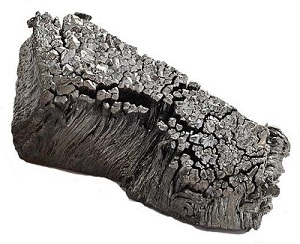Thulium Chemische Eigenschaften,Einsatz,Produktion Methoden
R-Sätze Betriebsanweisung:
R15:Reagiert mit Wasser unter Bildung hochentzündlicher Gase.
R17:Selbstentzündlich an der Luft. Spontaneously flammable in air.
R36/37:Reizt die Augen und die Atmungsorgane.
R34:Verursacht Verätzungen.
R23/24/25:Giftig beim Einatmen, Verschlucken und Berührung mit der Haut.
S-Sätze Betriebsanweisung:
S26:Bei Berührung mit den Augen sofort gründlich mit Wasser abspülen und Arzt konsultieren.
S36:DE: Bei der Arbeit geeignete Schutzkleidung tragen.
S43:Zum Löschen . . . (vom Hersteller anzugeben) verwenden (wenn Wasser die Gefahr erhöht, anfügen: "Kein Wasser verwenden").
S45:Bei Unfall oder Unwohlsein sofort Arzt zuziehen (wenn möglich, dieses Etikett vorzeigen).
S36/37/39:Bei der Arbeit geeignete Schutzkleidung,Schutzhandschuhe und Schutzbrille/Gesichtsschutz tragen.
S27:Beschmutzte, getränkte Kleidung sofort ausziehen.
Chemische Eigenschaften
grey chips
Physikalische Eigenschaften
Thulium is a naturally occurring rare metal that exists is very small amounts mixed withother rare-earths. It is a bright silvery metal that is malleable and ductile and can be cuteasily with a knife. Its melting point is so high that it is difficult to force it into a meltedstate. Its vapor pressure is also high, and thus, much of the molten thulium evaporates intothe atmosphere. Its melting point is 1,545°C, its boiling point is 2,950°C, and its density is9.32g/cm
3.
Isotopes
There are a total of 46 isotopes of thulium. One of these, Tm-169 is the onlystable isotope of thulium and accounts for the total atomic mass of the element. All theother isotopes are artificially produced and radioactive and have half-lives ranging from afew microseconds to two years.
Origin of Name
Named for Thule, the Greek word for Scandinavia, the most northerly
habitable land in ancient mythology.
Occurrence
Thulium is the 61st most abundant element in the Earth’s crust and is found along withother rare-earths in monazite sand, which is about 50% rare-earths by weight. Only about0.007% of this is thulium. It is also found in bastnasite ore. It ranks 16th out of the 17 rareearthsin abundance. Thulium is usually found as an oxide along with other rare-earths. Likemost rare-earths, thulium can be separated from its ore by the ion-exchange process, whereits positive ion reacts with elements with negative ions like fluorine, chlorine, or oxygen toform binary compounds (e.g., Tm
2O
2). It can also be recovered as a by-product of the nuclearfission reaction in nuclear reactors.
Charakteristisch
Thulium is near the end of the lanthanide series, where the metals tend to be heavier thanthe ones located near the beginning of the series. It is so scarce that it requires the processing ofabout 500 tons of earth to extract four kilograms of thulium. The only element that is scarceris promethium, which is not found naturally on Earth.
History
Discovered in 1879 by Cleve. Thulium
occurs in small quantities along with other rare earths in a
number of minerals. It is obtained commercially from monazite,
which contains about 0.007% of the element. Thulium is
the least abundant of the rare-earth elements, but with new
sources recently discovered, it is now considered to be about
as rare as silver, gold, or cadmium. Ion-exchange and solvent
extraction techniques have recently permitted much easier
separation of the rare earths, with much lower costs. Only a
few years ago, thulium metal was not obtainable at any cost;
in 1996 the oxide cost $20/g. Thulium metal powder now
costs $70/g (99.9%). Thulium can be isolated by reduction of
the oxide with lanthanum metal or by calcium reduction of
the anhydrous fluoride. The pure metal has a bright, silvery
luster. It is reasonably stable in air, but the metal should be
protected from moisture in a closed container. The element is
silver-gray, soft, malleable, and ductile, and can be cut with a
knife. Forty-one isotopes and isomers are known, with atomic
masses ranging from 146 to 176. Natural thulium, which is
100%
169Tm, is stable. Because of the relatively high price of the
metal, thulium has not yet found many practical applications.
169Tm bombarded in a nuclear reactor can be used as a radiation
source in portable X-ray equipment.
171Tm is potentially
useful as an energy source. Natural thulium also has possible
use in ferrites (ceramic magnetic materials) used in microwave
equipment. As with other lanthanides, thulium has a
low-to-moderate acute toxicity rating. It should be handled
with care.
Verwenden
Thulium(III) carbonate hydrate has specialized uses in ceramics, glass, phosphors, lasers, and also is the important dopant for fibre amplifiers. Thulium(III) carbonate hydrate has use in ferrites, ceramic magnetic materials that are used in microwave equipment.
Application
Thulium products are mainly used in making crystal and lasers.
An important application of the thulium in the Medicine area, and relatively independent of its high cost, is the production of portable X-ray sources. These sources are available for about one year, as tools in medical and dental diagnosis, as well as to detect defects in mechanical and electronic inaccessible components. This type of sources does not need excessive protection. Usually a small cap of lead is enough. Thulium can also be used in magnetic and ceramic materials (ferrite), similar to the Yttrium-iron alloys, nowadays used in the microwave technologies.
Thulium Metal, is mainly used in making superalloys, and has some application in ferrites (ceramic magnetic materials) used in microwave equipment and also as a radiation source of portable X-ray. Thulium potentially has use in ferrites, ceramic magnetic materials that are used in microwave equipment. it is used in arc lighting for its unusual spectrum.

Definition
thulium: Symbol Tm. A soft greymetallic element belonging to thelanthanoids; a.n. 69; r.a.m. 168.934;r.d. 9.321 (20°C); m.p. 1545°C; b.p.1947°C. It occurs in apatite and xenotime.There is one natural isotope,thulium–169, and seventeen artificialisotopes have been produced. Thereare no uses for the element, whichwas discovered by Per Cleve (1840–1905) in 1879.
Hazard
The dust and powder of thulium are explosive and toxic if inhaled or ingested. As with allradioactive elements, thulium can cause radiation poisoning.
Thulium Upstream-Materialien And Downstream Produkte
Upstream-Materialien
Downstream Produkte

